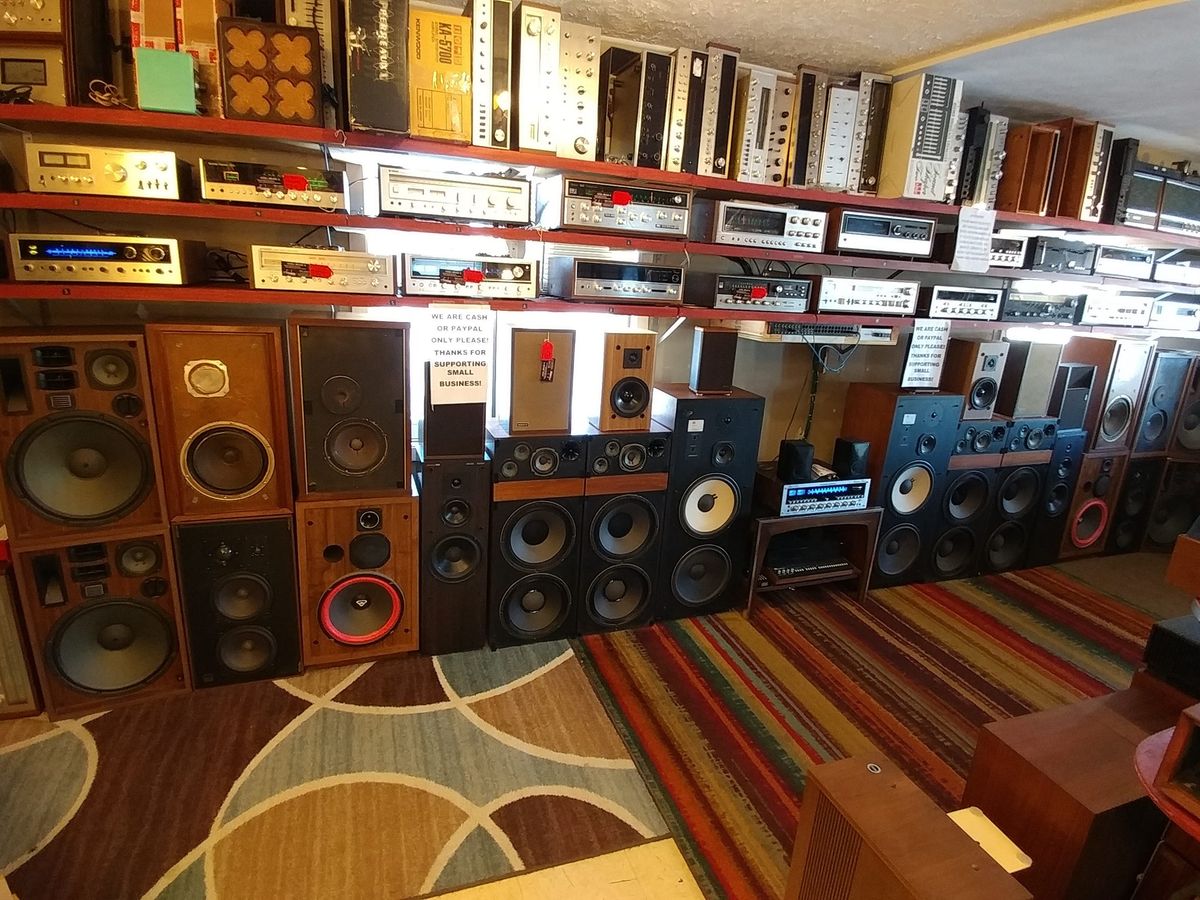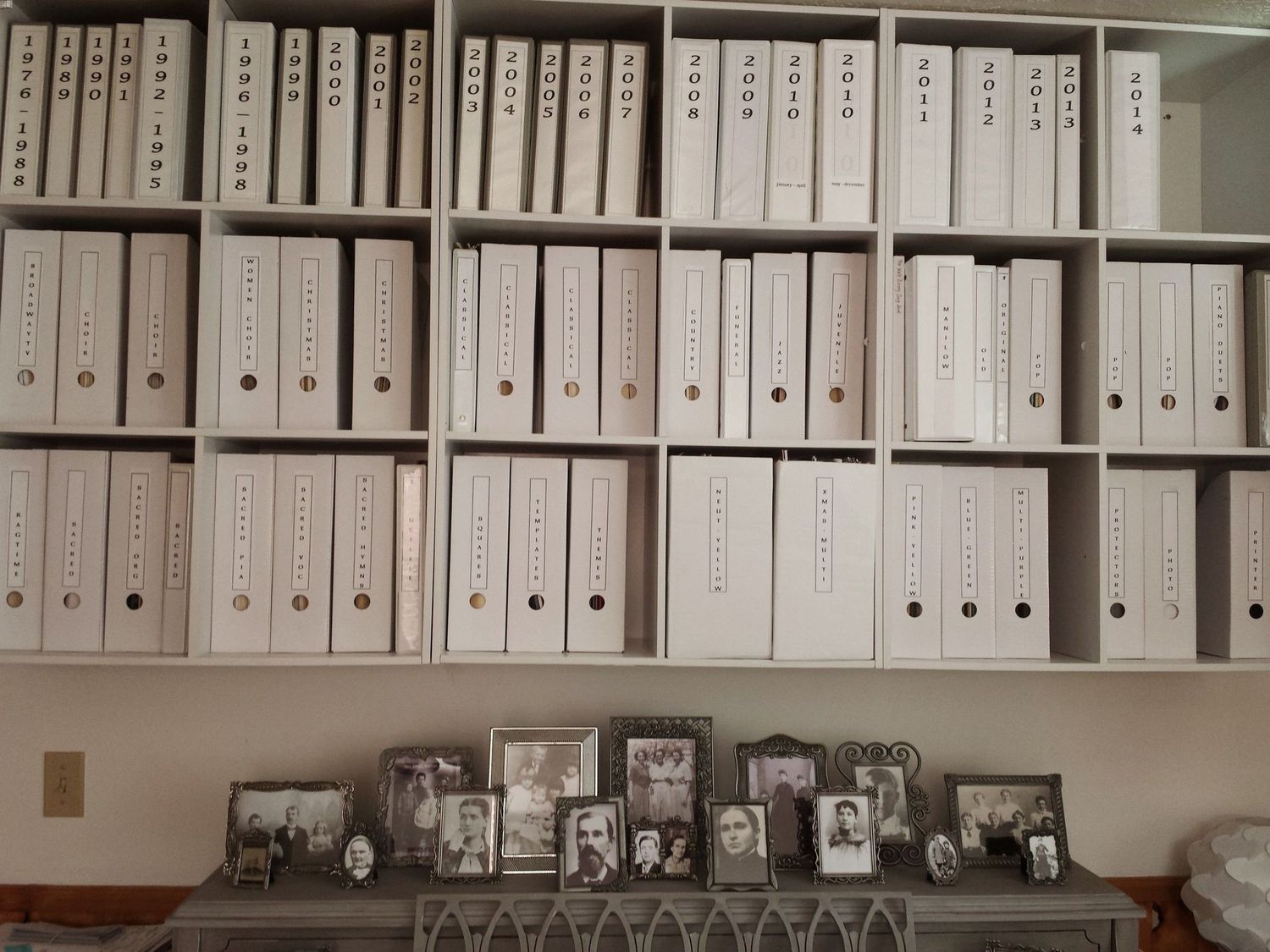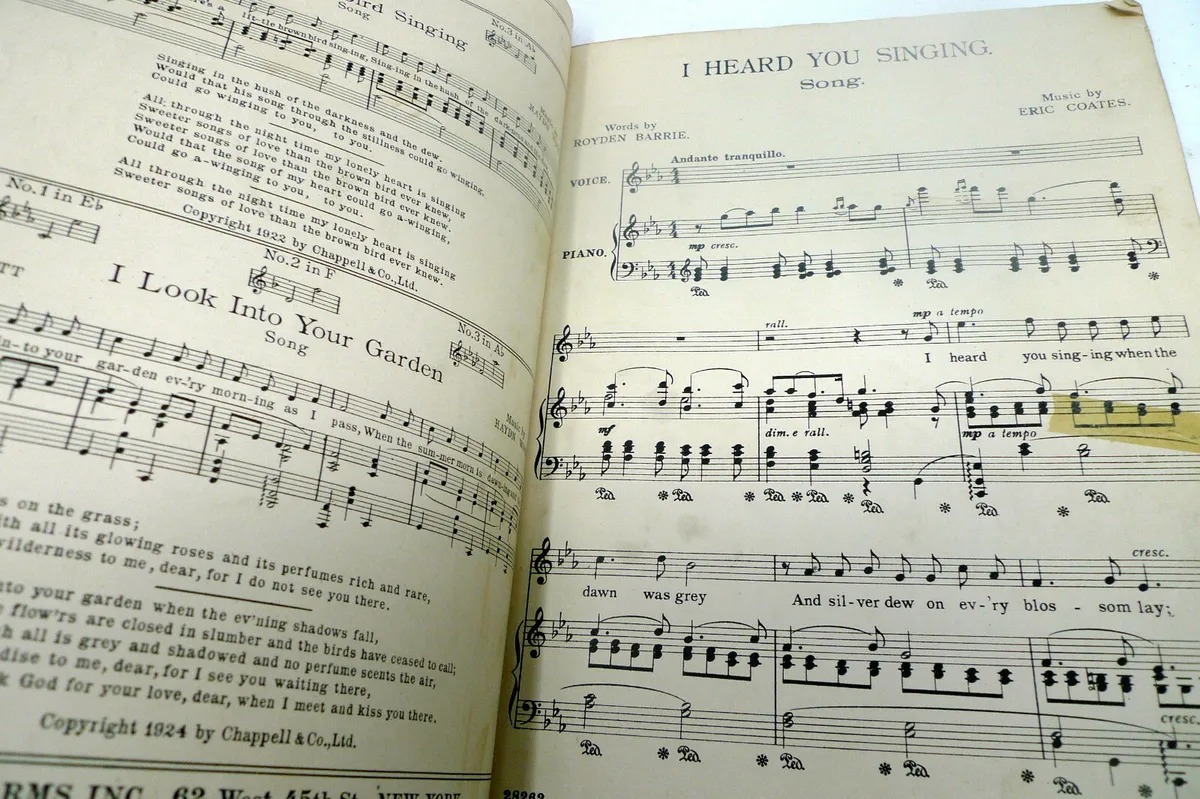Home>Production & Technology>Sheet Music>How To Sell Sheet Music


Sheet Music
How To Sell Sheet Music
Published: December 4, 2023
Discover the best strategies to sell sheet music online and maximize your profits. Learn how to reach a wider audience and effectively market your sheet music collection.
(Many of the links in this article redirect to a specific reviewed product. Your purchase of these products through affiliate links helps to generate commission for AudioLover.com, at no extra cost. Learn more)
Table of Contents
- Introduction
- Understanding the Sheet Music Market
- Preparing Your Sheet Music for Sale
- Choosing the Right Platform to Sell Sheet Music
- Creating an Eye-Catching Sheet Music Listing
- Pricing Your Sheet Music
- Promoting and Marketing Your Sheet Music
- Dealing with Copyright and Licensing
- Handling Transactions and Delivery
- Providing Excellent Customer Service
- Conclusion
Introduction
Welcome to the world of sheet music! Whether you are a talented musician, a composer, or someone with a passion for the beauty of musical scores, selling sheet music can be a rewarding endeavor. In this digital age, where everything seems to be easily accessible online, sheet music still holds its value and continues to be cherished by musicians and music enthusiasts around the world.
Sheet music, with its notations and symbols, captures the essence of a musical composition and brings it to life. It acts as a universal language that allows musicians to interpret and perform a piece of music with precision and emotion. Whether it’s classical, pop, jazz, or any other genre, sheet music serves as the medium through which musicians can bring their musical ideas to fruition.
If you have a collection of sheet music or have composed your own pieces, you have a valuable resource that can be shared with others and even monetized. Selling sheet music allows you to share your musical creations with a wider audience and create a potential source of income. However, navigating the world of selling sheet music can be challenging, especially if you are new to the market.
This comprehensive guide will walk you through the process of selling sheet music, from understanding the market to promoting your listings and providing top-notch customer service. Whether you are selling traditional sheet music or digital downloads, these tips and strategies will help you successfully navigate the sheet music industry.
So, if you’re ready to embark on this musical journey and turn your sheet music into a valuable asset, let’s dive in and discover the world of selling sheet music!
Understanding the Sheet Music Market
Before you start selling sheet music, it’s essential to have a firm understanding of the market. This includes knowing the demand for different genres, the preferences of musicians, and the platforms where sheet music is commonly sold.
One of the key factors to consider is the genre of the sheet music you plan to sell. Do your research and identify the genres that are currently in high demand. Classical music, for example, is timeless and has a dedicated following, while contemporary pop or film music may cater to a broader market. Understanding the popularity of various genres will help you strategize your sales approach and focus on the areas that have the most potential for success.
Another important aspect to consider is the target audience. Who are the potential buyers of your sheet music? Are you targeting professional musicians, hobbyists, or music students? Knowing your audience will enable you to tailor your marketing efforts and create listings that resonate with your target market.
When it comes to platforms, there are several options available for selling sheet music. Online marketplaces like Sheet Music Plus, Musicnotes, and Etsy are popular choices. These platforms provide a ready-made audience of music lovers and offer tools for creating and managing your sheet music listings.
In addition to online marketplaces, consider reaching out to local music stores, community organizations, and music schools. They may be interested in stocking physical copies of sheet music or partnering with you to sell digital downloads through their platforms. Building relationships with these institutions can expand your reach and provide additional avenues for selling your sheet music.
Understanding the sheet music market involves more than just knowing the demand and choosing the right platforms. It also requires awareness of the legal aspects and copyright considerations when selling sheet music. Familiarize yourself with copyright laws in your country and ensure that you have the necessary permissions to sell the sheet music you offer. This will protect you from potential legal issues and ensure that you are acting ethically and responsibly in the industry.
By gaining a thorough understanding of the sheet music market, you can position yourself for success and make informed decisions when it comes to pricing, marketing, and distribution. As you move forward in your journey to sell sheet music, remember to stay up to date with market trends and adapt your strategies accordingly. With the right approach, your sheet music can find its way into the hands of passionate musicians around the world.
Preparing Your Sheet Music for Sale
When it comes to selling sheet music, presentation is key. To ensure your sheet music stands out from the competition and appeals to potential buyers, it’s important to take the time to prepare it properly. Here are some steps to follow when getting your sheet music ready for sale:
- Ensure Accuracy: Before listing your sheet music for sale, double-check for any errors, inaccuracies, or missing pages. Your customers expect a high level of accuracy, so take the time to review and proofread your sheet music to ensure it is error-free.
- Format Professionally: If you’re selling digital downloads, present your sheet music in a professional format. This means using notation software like Finale or Sibelius to create clean and readable scores. Pay attention to layout, fonts, and spacing to make the sheet music visually appealing and easy to read.
- Create Cover Art: If you’re selling physical copies of sheet music, design an eye-catching cover. Use high-quality images, typography, and colors that reflect the mood or genre of the music. A visually appealing cover will attract attention and make your sheet music more enticing to buyers.
- Include Descriptive Information: When creating a sheet music listing, provide detailed and accurate information about the score. Include the title, composer, arranger (if applicable), instrument(s) it is intended for, and any additional notes or instructions. This information helps buyers make an informed decision and ensures they receive the correct sheet music.
- Add Sample Pages: Consider including sample pages of your sheet music in the listing or on your website. This allows potential buyers to get a glimpse of the music and assess its complexity or suitability for their needs. Select captivating and representative pages that showcase the best aspects of your sheet music.
- Edit and Revise: Continuously refine and improve your sheet music based on feedback and customer reviews. Take the time to listen to recordings or perform the music yourself to ensure it is accurate and musically satisfying. Regular updates and revisions show your commitment to quality and help build a loyal customer base.
By following these steps, you can ensure that your sheet music is well-prepared for sale, whether in physical or digital form. Remember to regularly review and update your listings to keep your sheet music content fresh and appealing. By presenting your sheet music in a professional and accurate manner, you increase your chances of attracting buyers and garnering positive reviews, which can lead to increased sales and a growing reputation in the sheet music marketplace.
Choosing the Right Platform to Sell Sheet Music
When it comes to selling sheet music, choosing the right platform is crucial. The platform you select will determine the visibility of your sheet music, the ease of listing and managing your inventory, and the overall experience for both you and your customers. Here are some factors to consider when selecting a platform:
- Audience Reach: Look for platforms that have a large and active community of musicians and music enthusiasts. Consider the platform’s user base, traffic, and engagement to assess the potential exposure your sheet music will receive.
- Genre Focus: Determine if the platform is suitable for the genre of your sheet music. Some platforms specialize in specific genres, such as classical music or contemporary pop, while others are more diverse. Choose a platform that aligns with your target audience and music style.
- Listing and Management Tools: Evaluate the platform’s listing and management features. Is it easy to create and update your sheet music listings? Can you easily track sales, inventory, and customer interaction? Look for a platform that offers robust tools to streamline your selling process.
- Payment and Transaction Options: Consider the payment and transaction options provided by the platform. Does it offer secure payment gateways? Can you easily handle refunds or customer inquiries? Efficient and secure payment processing is essential for a smooth selling experience.
- Pricing and Fees: Understand the pricing structure and fees associated with selling on the platform. Look for platforms that offer fair commission rates and transparent fee structures. Consider the impact of fees on your profit margins and factor them into your pricing strategy.
- Marketing and Promotion: Research how the platform supports marketing and promotion efforts. Does it provide tools for showcasing your sheet music, featuring top sellers, or offering promotional deals? Look for platforms that actively promote their sellers and have built-in marketing channels.
- Seller Support: Evaluate the level of support provided to sellers. Is there a dedicated customer support team available to assist with any issues or inquiries? Timely and reliable support is crucial when you encounter challenges or have questions.
- User Feedback and Reputation: Look for user reviews and feedback about the platform. Consider the experiences of other sheet music sellers to gauge the platform’s reliability, customer satisfaction, and overall reputation within the musical community.
Take the time to compare different platforms and assess how well they align with your goals and requirements. It may be beneficial to start with one platform initially and expand to others as you grow your sheet music business. Remember that each platform has its own unique characteristics, so choose one that best fits your needs and maximizes your chances of success.
Ultimately, the platform you choose should provide the necessary tools, resources, and exposure to help you effectively sell your sheet music and reach a wider audience of musicians and music lovers.
Creating an Eye-Catching Sheet Music Listing
When selling sheet music, creating an eye-catching listing is essential to attract potential buyers and differentiate your sheet music from others in the market. A visually appealing and informative listing will not only capture attention but also instill confidence in potential buyers. Here are some tips to create an eye-catching sheet music listing:
- Use High-Quality Images: Include high-resolution images of the sheet music cover and sample pages. Clear and professional images help potential buyers visualize the product and make an informed decision. Make sure the images are well-lit, accurately represent the sheet music, and highlight any unique features or selling points.
- Write a Descriptive Title: Craft a title that accurately describes the sheet music, using keywords that resonate with your target audience. Include information such as the title of the piece, composer, genre, and instrument(s) it is intended for. A concise and descriptive title will attract the right audience and improve search engine visibility.
- Provide Detailed Descriptions: Write a detailed description of the sheet music, including information about the difficulty level, key signature, tempo, and any special instructions. Highlight the unique aspects of the composition or arrangement to entice potential buyers. Use clear and concise language to communicate the features and benefits of the sheet music accurately.
- Include Customer Reviews: If you have received positive reviews from customers, showcase them in your listing. Testimonials create trust and credibility, showing that your sheet music has been well-received by others. Include snippets or summaries of reviews, along with the reviewer’s name or initials.
- Showcase Sample Recordings: Record or provide links to audio or video recordings of the sheet music being performed. Hearing the music brings it to life, demonstrating its musicality and potential. Providing sample recordings can be a powerful selling point that sets your sheet music apart from others.
- Highlight Unique Selling Points: Determine what makes your sheet music special and highlight it in your listing. Whether it’s a unique arrangement, a fresh interpretation, or a lesser-known piece, emphasize these selling points to attract buyers who are seeking something distinctive.
- Offer Multiple Formats: Consider offering your sheet music in different formats, such as physical copies, digital downloads, or both. This provides flexibility for customers with different preferences. Clearly indicate the available formats and any accompanying materials, such as audio tracks or MIDI files.
- Optimize for SEO: Incorporate relevant keywords throughout your listing to improve its visibility in search engine results. Research popular search terms related to your sheet music’s genre, composer, or instrument and include them naturally in your title and description. Avoid keyword stuffing and focus on creating a balanced, informative, and engaging listing.
Remember that your sheet music listing is often the first impression potential buyers will have of your product. By investing time and effort into creating an eye-catching and informative listing, you can capture the attention of your target audience and increase the chances of converting visitors into customers.
Pricing Your Sheet Music
Setting the right price for your sheet music is crucial for attracting buyers while also ensuring that your efforts are adequately compensated. Determining the ideal price requires a careful balance between market demand, perceived value, and profitability. Here are some factors to consider when pricing your sheet music:
- Research the Market: Start by researching the prices of similar sheet music on different platforms. Look for sheet music in the same genre, difficulty level, and format to gain an understanding of the market standards. Consider the prices of best-selling sheet music as well as those from established composers or arrangers.
- Evaluate the Quality and Originality: Take into account the quality and originality of your sheet music. If you have arranged a popular piece in a unique way or composed an original composition, you may be able to justify a higher price. Highlight any distinctive features of your sheet music that make it stand out from the competition.
- Consider the Difficulty Level: Factor in the difficulty level of your sheet music. More complex or challenging pieces may warrant a higher price, as they require a higher skill level to perform. On the other hand, beginner-friendly arrangements may be priced lower to cater to a wider audience.
- Value Proposition: Determine the value your sheet music offers to musicians. Think about the benefits it provides, such as unique arrangements, comprehensive notation, or additional instructional materials. Consider pricing your sheet music based on the added value it brings to the buyer.
- Production Costs: Take into account any costs involved in producing the sheet music, such as notation software, editing, printing, or distribution fees. Calculate these costs and factor them into your pricing strategy to ensure you cover your expenses and maintain profitability.
- Customer Perception: Consider how potential buyers perceive the price of your sheet music. Very high or very low prices may impact their perception of value. Strive for a price that represents the quality and appeal of your sheet music and aligns with buyers’ expectations.
- Promotions and Discounts: Consider offering promotional prices or discounts to attract buyers. Launching your sheet music with an introductory discount or running limited-time promotions can generate interest and encourage sales, especially when starting out.
- Monitor and Adjust: Continuously monitor the performance of your sheet music sales and make adjustments as needed. If you’re not attracting customers at a particular price point, consider experimenting with different pricing strategies to find the sweet spot that maximizes sales and profitability.
Remember to strike a balance between offering competitive pricing and appropriately valuing your work. Regularly evaluate the market and customer feedback to ensure your sheet music remains competitively priced and in line with industry standards. By carefully considering these factors, you can set a price that not only attracts customers but also rewards your effort and creativity.
Promoting and Marketing Your Sheet Music
Even with exceptional sheet music, it’s important to actively promote and market your compositions to reach a wider audience and increase sales. Here are some effective strategies to promote and market your sheet music:
- Build an Online Presence: Create a website or a dedicated page where you can showcase and sell your sheet music. Optimize it by including relevant keywords, clear descriptions, and high-quality images. Make sure your website is user-friendly and easily navigable.
- Utilize Social Media: Harness the power of social media platforms to connect with your target audience. Create accounts on platforms such as Facebook, Instagram, Twitter, and YouTube, and regularly share updates, performance videos, and previews of your sheet music. Engage with followers, respond to comments, and build a community around your music.
- Collaborate with Influencers: Seek opportunities to collaborate with musicians, music bloggers, YouTubers, or social media influencers who have a following in your target market. Offer them free copies of your sheet music in exchange for reviews, performances, or social media shout-outs. Their endorsement can help amplify your reach and credibility.
- Create Video Performances: Produce high-quality video performances of your sheet music to showcase its beauty and appeal. Upload these videos to YouTube or other video-sharing platforms, and include links to purchase your sheet music in the video descriptions. Sharing visually engaging and musically captivating videos can attract potential buyers and generate interest in your compositions.
- Participate in Online Communities: Become an active member in online forums, communities, and social media groups focused on music, composition, or specific instruments. Share your expertise and answer questions, and subtly promote your sheet music when relevant. Engaging with like-minded individuals in these communities can help you establish credibility and expand your network.
- Offer Free Samples or Downloads: Provide free samples or downloadable excerpts of your sheet music to give potential buyers a taste of your compositions. This allows them to assess the quality and style of your music before making a purchase decision. You can offer these samples through your website or social media platforms.
- Run Promotions and Discounts: Periodically run promotions or discounts to incentivize potential buyers. Offer limited-time discounts, bundle deals, or buy-one-get-one offers to encourage purchases. Promote these special offers through your website, social media channels, and email newsletters.
- Collaborate with Music Teachers: Reach out to music educators or teachers who may be interested in using your sheet music for their students. Offer them special discounts or access to exclusive educational materials. By getting your sheet music into the hands of music students, you increase its exposure and potential for future sales.
- Seek Opportunities for Performances: Actively seek opportunities for your sheet music to be performed live in concerts, recitals, or competitions. Contact local music schools, community centers, and performing arts organizations to share your compositions. Being featured in live performances not only promotes your sheet music but also establishes you as a recognized composer.
- Collect and Showcase Testimonials: Encourage buyers to leave reviews and testimonials about your sheet music. Feature these positive reviews on your website, social media platforms, and in your sheet music listings. Testimonials build trust and credibility, making potential buyers more confident in purchasing your compositions.
Remember that consistent and targeted promotion is key to enhancing the visibility of your sheet music. Combine multiple strategies and adapt your approach based on their effectiveness. With diligent marketing efforts, you can attract a larger audience and increase your sheet music sales.
Dealing with Copyright and Licensing
When selling sheet music, it’s crucial to understand and comply with copyright laws and licensing requirements. Respecting intellectual property rights not only ensures legal compliance but also protects the rights of composers, arrangers, and copyright holders. Here are some important considerations when dealing with copyright and licensing:
- Know Your Rights: Familiarize yourself with copyright laws in your country or region. Understand the rights granted to composers, arrangers, and copyright holders, such as the exclusive right to reproduce, distribute, and perform their work. Educate yourself on the duration of copyright protection and any exceptions or limitations that may apply.
- Obtain Permission: If you are arranging or adapting copyrighted music, seek permission from the copyright holder before selling your sheet music. Contact the original composer or their authorized representative to obtain a license to sell your arrangement. This ensures that you are legally allowed to monetize your sheet music without infringing on someone else’s rights.
- Public Domain Music: Consider selling sheet music of compositions that are in the public domain. Public domain music is not subject to copyright restrictions, typically because its copyright has expired. Ensure that you have verified the public domain status of the music before selling it under the presumption that it is copyright-free.
- Use Royalty-Free Music: Utilize royalty-free music for your original compositions. Royalty-free music is created with the explicit intent to be used without the need for additional licensing fees. However, it’s important to review the specific terms of each royalty-free music resource or library to ensure compliance with their licensing agreements.
- Consider Creative Commons Licensing: If you wish to allow certain uses of your sheet music while maintaining some control, consider utilizing a Creative Commons license. This allows you to specify the permissions you grant to others (such as allowing free personal use but requiring attribution) upfront, while still retaining your copyright.
- Research Royalty Collection Societies: Familiarize yourself with royalty collection societies in your country or region. These organizations ensure that composers and copyright holders receive royalties for the public performance or use of their music. If you plan to sell physical copies of sheet music that may be publicly performed, joining a royalty collection society may be necessary to ensure fair compensation.
- Educate Your Customers: Clearly communicate any licensing restrictions or permissions associated with your sheet music to your customers. Include disclaimers or licensing information in your listings or on your website to avoid any confusion or misuse by the buyers. Provide guidance on the proper use and permissions required for performance or recording of your sheet music.
- Respect Authorship: Always credit composers, arrangers, and copyright holders appropriately, acknowledging their contribution to the music. As a seller and promoter of sheet music, show respect for the work of others and encourage your customers to do the same.
Navigating the complex landscape of copyright and licensing can be challenging, but it is essential to protect the rights of creators and maintain legal compliance in your sheet music business. By being knowledgeable about copyright laws, obtaining proper permissions, and respecting licensing requirements, you can sell your sheet music with confidence, knowing that you are operating ethically and responsibly in the industry.
Handling Transactions and Delivery
Efficiently handling transactions and delivery is crucial for a smooth selling process when it comes to selling sheet music. Providing a seamless experience for your customers will not only help build a positive reputation but also encourage repeat business. Here are some important considerations when it comes to handling transactions and delivery:
- Secure Payment Methods: Utilize secure payment methods to protect both you and your customers. Offer options such as credit card payments, PayPal, or other trusted payment gateways. This helps instill confidence in your customers and ensures that their financial information is protected.
- Clear Return and Refund Policy: Establish a clear return and refund policy to address any issues or dissatisfaction that may arise. Clearly communicate the terms and conditions of refunds or exchanges, including any time limitations or product requirements. Display this policy prominently on your website or in your listing to manage customer expectations.
- Automation and Digital Delivery: Consider implementing a system for automated digital delivery of sheet music. This provides instant access to customers upon purchase, eliminating shipping costs and delays associated with physical products. Use secure download links or dedicated download platforms to ensure a smooth and secure digital delivery process.
- Shipping Physical Copies: If you offer physical copies of your sheet music, package them securely to prevent damage during transit. Use appropriate packaging materials, such as sturdy envelopes or cardboard-backed mailers, to protect the sheet music from bending or tearing. Consider purchasing shipping insurance to provide additional coverage in case of loss or damage.
- Tracking and Confirmation: For physical shipments, provide customers with tracking numbers or delivery confirmation. This allows them to track the progress of their package and ensures a sense of security. Promptly communicate tracking information to the customer after the shipment has been dispatched.
- Customer Support and Communication: Be responsive to customer inquiries and provide prompt support when needed. Monitor your email or messaging platforms regularly and respond to queries in a timely manner. Clear and efficient communication helps build trust and ensures a positive buying experience.
- International Shipping Considerations: If you offer worldwide shipping, be aware of any additional customs duties, taxes, or import fees that may apply. Clearly communicate these potential charges to international customers to prevent unexpected surprises. Research international shipping regulations and restrictions to ensure compliance.
- Manage Inventory: Keep track of your inventory to prevent overselling. Regularly update your listings or website to reflect the availability of your sheet music. Having accurate inventory management reduces the risk of disappointing customers due to out-of-stock items.
- Solicit Feedback: Encourage customers to provide feedback on their buying experience. This can be done through post-purchase emails or survey requests. Valuable feedback allows you to improve your processes and address any issues that may arise.
By implementing efficient transaction handling and delivery processes, you can ensure customer satisfaction and streamline your operations. Providing a secure and reliable buying experience increases customer trust and enhances your reputation as a dependable seller of sheet music.
Providing Excellent Customer Service
Delivering excellent customer service is essential in the sheet music business. Building strong customer relationships not only leads to repeat business but also fosters positive word-of-mouth recommendations. Here are some key considerations for providing excellent customer service:
- Quick and Responsive Communication: Respond to customer inquiries, questions, and concerns promptly. Aim to provide timely and helpful responses, whether it’s through email, social media, or other communication channels. A quick and efficient response demonstrates your dedication to customer satisfaction.
- Personalized Interactions: Strive to create a personal connection with your customers. Address them by name, personalize your messages or emails, and show genuine interest in their musical needs. This personal touch makes customers feel valued and appreciated.
- Professional and Friendly Tone: Maintain a professional and friendly tone in all your interactions. Be courteous, empathetic, and patient when addressing customer concerns or issues. A positive and respectful attitude goes a long way in building trust and loyalty.
- Knowledgeable and Helpful Assistance: Be knowledgeable about your sheet music and willing to provide assistance to customers. Help them find the right pieces for their needs, offer recommendations or suggestions when requested, and provide any additional information or resources they may require.
- Resolve Complaints Effectively: Address customer complaints or problems promptly and effectively. Apologize for any issues, take responsibility for resolving them, and offer appropriate solutions or compensation. Turning a negative experience into a positive one showcases your commitment to customer satisfaction.
- Appreciate Feedback: Encourage customers to provide feedback on their experience or any improvements they suggest. Show gratitude for their input and use it to enhance your products or services. Actively seek and consider customer feedback to continually improve and meet their needs.
- Follow Up: After a purchase, consider following up with customers to ensure they are satisfied with their sheet music and overall experience. A follow-up email or message shows that you care about their satisfaction and reinforces your commitment to customer service.
- Educational Resources: Provide additional educational resources related to your sheet music. This could include practice tips, instructional videos, or tutorial guides. Offering these resources demonstrates your commitment to supporting customers in their musical journey.
- Thank Customers for Their Support: Show appreciation to your customers for choosing your sheet music. Include a personalized thank-you note or a small token of appreciation, such as a discount code for future purchases. This gesture makes customers feel valued and encourages them to return for future sheet music needs.
- Build a Community: Foster a sense of community among your customers. Consider creating a forum, Facebook group, or online community where customers can connect with each other, ask questions, and share their experiences. Building a community around your sheet music creates a supportive and engaged customer base.
By providing excellent customer service, you can differentiate yourself from competitors and build a loyal customer base. Word-of-mouth recommendations from satisfied customers can be a powerful tool in growing your sheet music business and establishing a strong presence in the industry.
Conclusion
Selling sheet music can be a fulfilling and rewarding endeavor, allowing you to share your musical creations with a wider audience and potentially generate income. By following the steps outlined in this comprehensive guide, you can navigate the sheet music market and position yourself for success.
Understanding the sheet music market, preparing your sheet music for sale, choosing the right platform, creating engaging listings, pricing your sheet music appropriately, and effectively promoting and marketing your compositions are all critical aspects of a successful sheet music business. Additionally, ensuring compliance with copyright and licensing regulations, handling transactions and delivery efficiently, and providing excellent customer service are key to creating a positive buying experience for your customers.
Remember, building a strong reputation and loyal customer base takes time and dedication. Continuously refine your sheet music, stay updated with industry trends, and adapt your promotional strategies to meet the evolving needs of your target market. Embrace customer feedback and use it to enhance your offering and improve customer satisfaction.
With passion, creativity, and a customer-centric approach, you can thrive in the sheet music market, sharing the beauty of music through your compositions and arrangements. So, get ready to embark on this musical journey, and may your sheet music compositions find their way into the hands of musicians who will appreciate and enjoy them!











